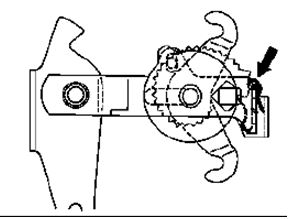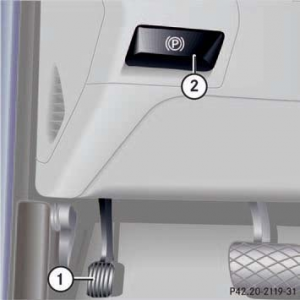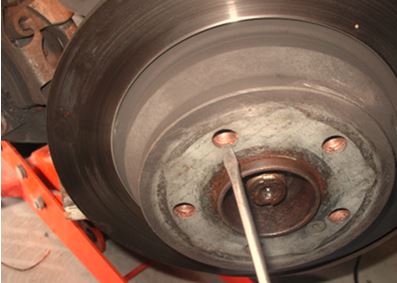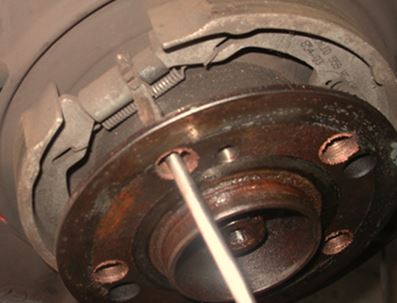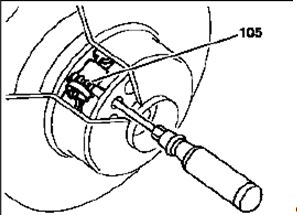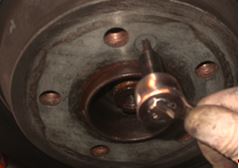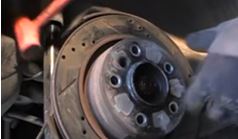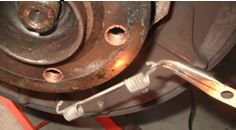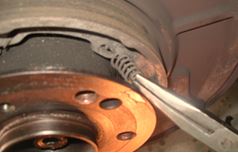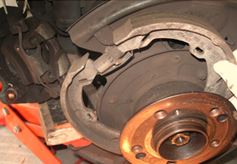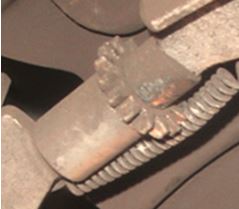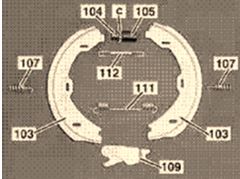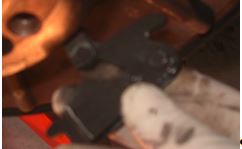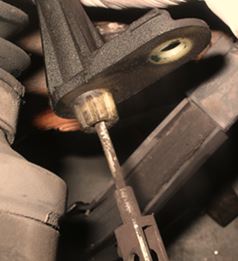Parking brake
Description - Parking Brake
When parked on an incline, gear shift position P alone may not prevent your vehicle from moving, possibly hitting people or objects. Always set the parking brake in addition to shifting to position P. TIP: On steep slopes, turn the front wheels towards the curb.
- Parking brake pedal
- Parking brake release handle
Step firmly on parking brake 1.
When the engine is running, the indicator lamp in the instrument cluster illuminates.
Release the parking brake by pulling handle 2.
The indicator lamp in the instrument cluster goes out.
DIY Procedures - Parking Brake
Adjusting - Parking Brake
- Release Parking Brake
- Unload Automatic Cable Slack Adjuster - Parking Brake See below.
- Take off the rear wheel, observe how freely the rotor turns while turning it by hand.
- Rotate the right side wheel so that the access hole (any wheel bolt hole) is positioned at 11:00 o’clock position to provide access to the parking brake thumbwheel (ratchet mechanism). (For the left side wheel the access hole (wheel bolt hole) is positioned at the 1:00 o’clock position.
- Note the correct angle for the wide bladed screw driver tip.
- Shine a flashlight into the hole (or use a video inspection camera) to see what the tooth of the thumbwheel inside looks like.
- Insert a flat blade screwdriver through the hole and catch between two teeth.
- Adjust the parking brake shoes to provide maximum clearance. The next Figure shows an the internal View of Parking Brake Thumbwheel. This is what you are trying to do.
- Start moving the screwdriver handle upward (tip of the screwdriver moving downward) to turn the adjusting wheel clockwise, do about two turns and turn the rotor to see if there is a slight resistance turning the rotors and adjust more or less depending on the resistance.
- Once the rotor will not turn, backoff the thumbwheel adjustment about five notches until the rotor will turn freely. TIP: Both sides should be backed off the same amount.
- Finally Preload Brake Automatic Cable Slack Adjuster. See below.
Replacing - Parking Brake
- Unload Parking Brake Automatic Cable Slack Adjuster See below.
- Take off the rear wheel, observe how freely the rotor turns while turning it by hand.
- Rotate the right side wheel so that the access hole (any wheel bolt hole) is positioned at 11:00 o’clock position to provide access to the parking brake thumbwheel (ratchet mechanism). (For the left side wheel the access hole (wheel bolt hole) is positioned at the 1:00 o’clock position.
- Note the correct angle for the wide bladed screw driver tip.
- Shine a flashlight into the hole (or use a video inspection camera) to see what the tooth of the thumbwheel inside looks like.
- Insert a flat blade screwdriver through the hole and catch between two teeth.
- Adjust the parking brake shoes to provide maximum clearance. The next Figure shows an the internal View of Parking Brake Thumbwheel. This is what you are trying to do.
- Rotate the parking brake thumbwheel (ratchet mechanism) downwards (screw driver handle upwards) to release the brake to its maximum clearance.
- Remove the Torx screw holding brake disk to rear axle shaft flange.
- Remove the Brake Disk to gain access to the parking brake mechanisms. TIP: If you haven’t previously used anti-seize grease on the hub you may have to tap the disc with a rubber mallet.
- Remove the Parking Brake Lower Retracting Spring. This requires a fair bit of effort but it is possible with normal 45º long nose pliers.
- Remove the Brake Shoe Retaining Springs. Remove the two rear brake shoe retaining springs by pushing them inwards and twisting 90º.
- Note the Retaining Springs Alignment for Re-installation. TIP: The installed position of the retaining springs is such that the hook end is facing radially inwards and pointing directly at the centre of the wheel hub.
- Remove the Parking Brake Shoes and Adjusting Mechanism over the Wheel Hub.
- Note the Orientation of the Parking Brake Adjusting Thumbwheel. TIP: The thrust piece (shorter length) is towards the front of the vehicle on both sides. The next Figure shows the right side wheel.
- Store the Parking Brake. TIP: Store the parking brake out of the way maintaining the correct positioning for each component to aid in re-installation.
- Remove the Parking Brake Expansion Lock. TIP: Carefully remove the parking brake expansion lock (actuating mechanism) and note the orientation. The hooked end of the Expansion Lock (109) is towards the front of the vehicle on both sides. The next Figure shows the right side wheel.
- Remove the Parking Brake Cable. TIP: Remove the bolt and withdraw the parking brake cable and place out of the way.
- Reinstall in reverse order remembering to Preload Brake Automatic Cable Slack Adjuster. See below.
Unload Automatic Cable Slack Adjuster - Parking Brake
Release the Parking Brake Cable Automatic Tensioning Mechanism from underneath the car. This releases any tension in the parking brake cables and the cables may even be taken off the Tensioning Mechanism if required. TIP: It can take several attempts to get this right. The trick is to rotate the detent eccentric bolt (g) counter clockwise when viewed from underneath until it clicks into place into the hold down clip spring (d).
Preload Automatic Cable Slack Adjuster - Parking Brake
Using a flat bladed screw driver push in the direction of the arrow to release the hold down clip (d) on the brake automatic cable slack adjuster. This tensions both parking brake cables and the cable slack adjuster will set itself automatically.

